How will Oregon pay for a major expansion of the I-5 freeway between Portland and Vancouver (also known as the Interstate Bridge Replacement Program)? We’ve known for a while that the magic number for Oregon’s share would be $1 billion — that’s the amount the state of Washington has already pledged, and with a project estimated to cost as much as $7.5 billion, the federal government needs to see cooperation and a local match before they’re willing to award coveted infrastructure grants.
With the clock ticking and all eyes on Oregon, we finally know how our state plans to come up with the money: they want to borrow it.
Last Wednesday the Oregon Legislature’s Joint Committee on Transportation revealed a plan to bond against $700 million in Oregon Department of Transportation state highway fund tax revenue (which comes from gas taxes, vehicle registration fees, and fees from freight trucks). The remaining $300 million would come from bond sales from the state’s general fund. The state would be on the hook to pay back these debts beginning in 2026.
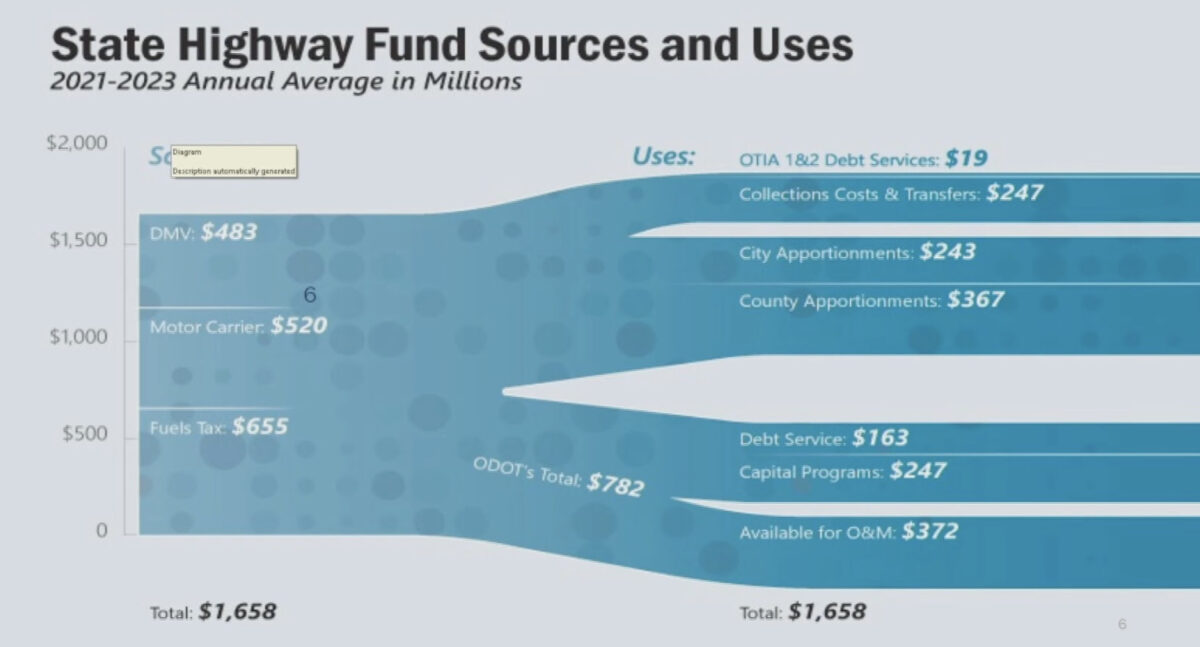
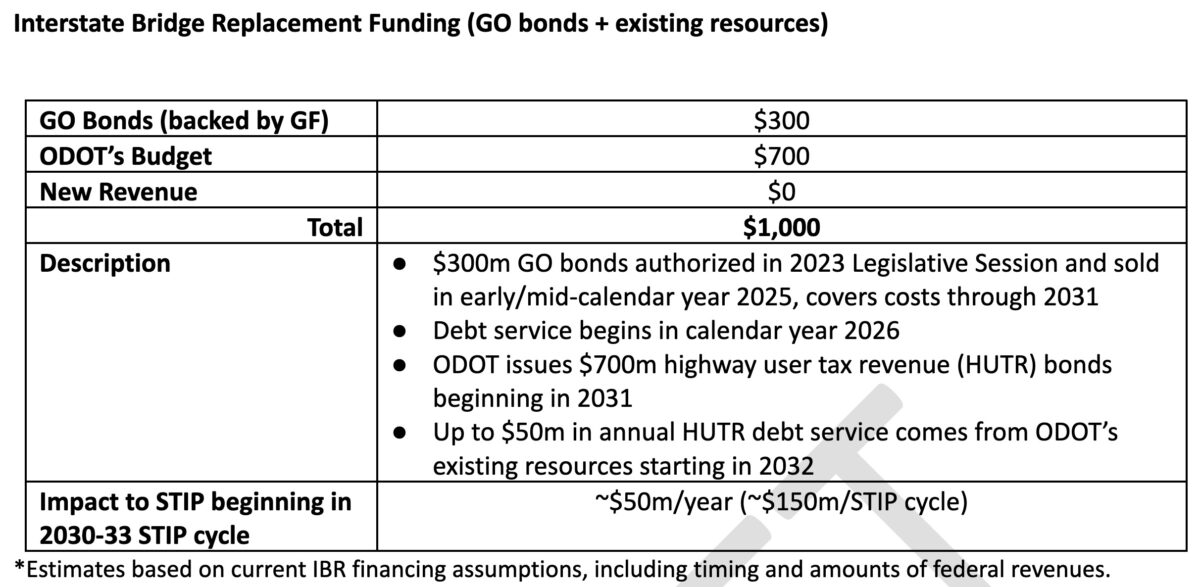
The payback would hit ODOT funding in particular starting in 2032, when they estimate it would carve $50 million per year out of the Statewide Transportation Improvement Program. To put that debt into perspective, it’s almost the same amount ODOT spends on public transit statewide each year ($60 million). It would also add to ODOT’s already heavy debt load. Of the $782 million ODOT receives from the state highway fund each year, just over 20% of it — $163 million — goes directly to debt service.
Another element of the funding plan is that lawmakers would set a hard cap for the total cost of the project so that it may not exceed $6.3 billion. It’s worth noting that when ODOT released their updated cost estimate back in December, they gave a range of $5 to 7.5 billion and settled on $6 billion as the most likely number; so while that cap is right in line with ODOT’s own estimates, it at least puts up some guardrails about runaway costs and it could be seen as a small overture from lawmakers that they don’t trust ODOT with a blank check.
The funding plan reveals desperation from lawmakers as tensions continue to rise about how ODOT will stay solvent in light of an ever-expanding portfolio of megaprojects and an ever-shrinking pot of money to pay for them. ODOT is obligated by the legislature start a tolling program to help pay for projects like this one, but that process will be anything but easy as they navigate skeptics across the public and political spectrum.
The Joint Committee on Transportation will have to take up a bill this session to initiate their plan. According to stories from The Oregonian and OPB last week, that will happen in April. If it all goes according to plan, ODOT would issue the bonds in 2025 — the same year the Oregon Legislature plans to pass its next large transportation funding package.
While this funding plan hasn’t been scheduled for a public hearing yet, it will very likely be discussed tomorrow (Tuesday, March 28th) when ODOT leaders return to the Joint Committee on Transportation to brief lawmakers on their budget. The informational session is being continued from March 7th when lawmakers grilled ODOT about their spending priorities and left several questions unanswered.
Speaking of unanswered questions, the I-5 expansion and bridge replacement project has been dogged by them. Earlier this month the U.S. Coast Guard forced the project team to analyze a lift-span design, a move the project team hoped to avoid and that could sow further doubt and delays.
Adding to the cauldron of concern, lawmakers will also soon hear from activists who plan to descend on the capitol building on April 13th for what’s being billed as the Transportation Future Day of Action. The event is co-organized by the Just Crossing Alliance and is part of the “Right Size, Right Now!” campaign that seeks to convince legislators to re-think their approach to the IBRP project.
“We can’t let this behemoth bankrupt our state and our children’s climate future,” reads a statement about the event. “The current design is oversized and will suck up our state’s transportation funds for the next couple of decades and leave us without dollars to fill potholes, invest in safe streets and routes to school, or prioritize active transportation and public transportation. The current design is a five-mile freeway expansion that far outreaches the need for a safe, earthquake proof bridge and will increase traffic and greenhouse gas emissions.”


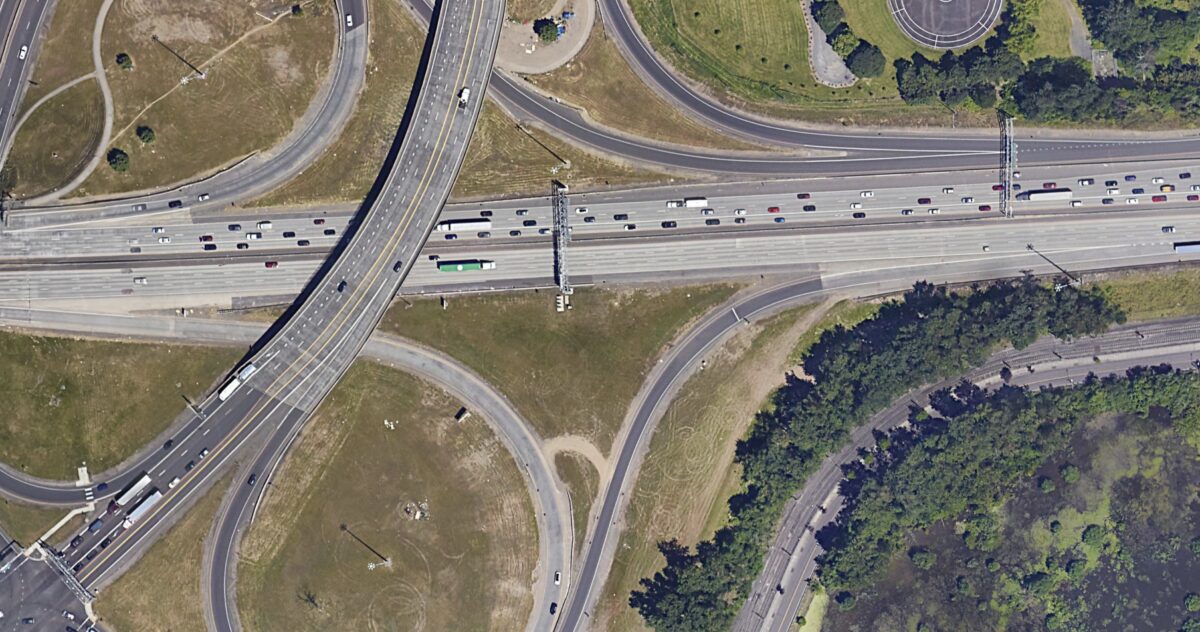

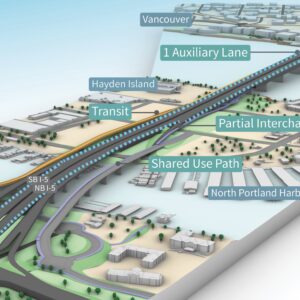
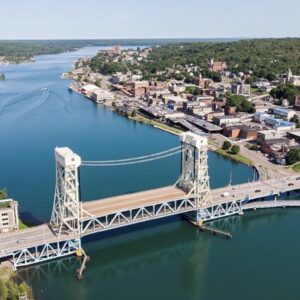
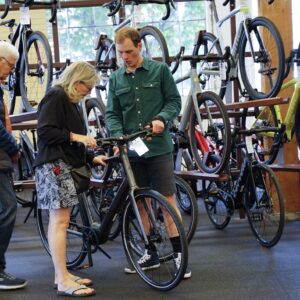

Thanks for reading.
BikePortland has served this community with independent community journalism since 2005. We rely on subscriptions from readers like you to survive. Your financial support is vital in keeping this valuable resource alive and well.
Please subscribe today to strengthen and expand our work.
I’m really excited for your post in March of 2027 about how ODOT is asking for the hard cap to be removed because the project is going to go way over budget and over deadline.
This project is going to exceed $10 billion with almost certainty. We’re talking about ODOT here. They didn’t factor in the net present value and future value to the Rose Quarter project.
Yep, and all they will have to say is “we’ve already spent $6 billion, it’s only $1 billion more” and no law maker will be willing to buck that. Then, when it passes $7 billion, rinse and repeat. This project needs to be killed (again) before it starts or it will be completed at any cost owing to inertia.
“Just one more billion bro, it’ll be different this time I swear”
Do we even need that section of i5 up to where it connects with 405? How about we spend that money on tearing it down, filling back in lower Albina, and opening up the east bank waterfront back to the people? Like what SF did or Seattle
This x100. Space for people, not cars por favor
The Alaskan Way viaduct replacement debacle is a great look into induced demand as well. When it was torn down, traffic engineers in the region predicted an apocalyptic meltdown but there wasn’t much of a change in peak travel times. They did replace the viaduct with a tunnel that is going to have to take a bailout since toll revenues have been so much lower than projected. Turns out traffic engineers don’t really make accurate predictions of human behavior. I will say the replacement road on Alaskan way leaves a lot to be desired from a pedestrians perspective though.
It took an earthquake to remove the Embarcadero viaduct (and the Nisqually quake in the Seattle region spurred the discussion to remove the Alaskan Way structure to avoid a collapse as well). I’m hopeful we can find a way to do more freeway removal in Portland too, but the least we can do is kill any and all freeway expansions in the city until the big one hits I guess.
amen
$1B is an abstract number to most people. I’d really like this stated in $x per Oregon resident per year for y years. Or “here’s how much the bridge toll has to be to pay for this in y years.”
Lucky for you, that’s spelled out directly in the article ($50 million/year starting in 2032)
$50 million per year for roughly 16 years given the current interest rate for Oregon State bonds. The good news is, that rate is really low at 1.8%. That means we would bonding against ~$814 million of actual tax revenue.
The bad news is, ODOT has no hope of bringing in any project on budget. That’s difficult for any agency but ODOT has a really bad record. There’s no consequence for going over budget. As someone pointed out above, we’re not going to leave part of a bridge hanging up there. What is a “hard cap” in this context?
It looks like Oregonians will have to keep driving a lot more – fuel tax – into the future to pay off the ODoT bonds for their share of the IBR.
At least the design discussion is getting getting interesting again…
https://www.columbian.com/news/2023/mar/13/stober-study-tunnel-for-interstate-bridge-replacement-program/
And the Columbia has said NOTHING about potential residential or business displacement in downtown Vancouver by the freeway ecpansion north of the Columbia. Their concern is still.blindly and stupidly focused on the alleged ability of more freeway lanes to free up traffic flow.
From what I’ve seen there should be little to no business displacement needed for the bridge on the Washington side. The original plan called for tearing several buildings down for a MAX park and ride, but those properties have since been developed with new office and apartment buildings. I don’t know how things will change if they switch from a two-level bridge to a single-level one.
The biggest impact will be the bridge looming over the downtown area.
https://www.columbian.com/news/2023/mar/19/in-our-view-drawbridge-tunnel-miss-mark-for-i-5-bridge/
The Columbian highlights the value of BP in providing unbiased reporting. The Columbian has been and continues to be a strong freeway expansion advocate because they have a huge vested interest in developing their property west of Downtown Vancouver and view the freeway expansion as an opportunity to fund some of the local street improvements that will funnel cars from I-5 to their development. One example of many in how special interest groups influence freeway decision making for their own benefit. Highways get expanded, special interest groups promoting the expansion are benefited, a lot of others including those who simply want to walk or ride a bike get hurt.
Time to start gathering signatures for a statewide ballot measure to kill this project before it swallows any more of our money. Rural conservatives will happily join with the climate aware to kill this Portland mega boondoggle.
I would help with this. Post details and a way to message. If you build the trojan horse to kill ODOT waste the people will come inside.
The problem with the I-5 expansion, as I see it, is that the ODOT/WSDOT group is trying to solve 120 problems with one design. Has anyone considered the following bridge-and-tunnel scheme?
Of course ODOT won’t consider this scheme b/c they do only mega-projects that guarantee them the biggest budget. But think how poorly the current design serves everyone but car- and truck-drivers. A local bridge crossing would be superior in many respects.
Yes, they are trying to solve all the competing transportation challenges with a single project. Hence why the common sense alternative proposal is so appealing.
The bridge can’t be too high, or the FAA won’t approve it due to Pierson Field.
The bridge can’t be too low, or the Coast Guard won’t approve it without a draw bridge.
The DoTs don’t want to stop freeway traffic for bridge lifts.
Clark County doesn’t want transit.
Portland won’t support it without transit.
They have to accommodate interstate traffic traveling long distances.
They have to provide local connections for downtown Vancouver, Hayden Island, and the industrial areas.
Clearly all of those would be better serves by a series of smaller, focused projects, not a single one, but that’s not how our funding system is set up. Instead of long term, sustainable (financial and environmental) thinking, we throw billions at giant capital projects, but not at maintaining them once they’re built. We just assume that in another 50 years there will be another megaproject that will replace the current megaproject.
You forgot one, the Coast Guard doesn’t want additional bridge piers between the existing I5 bridge and the railroad bridge. It will further complicate the currents for ships.
So no new bridges between the existing ones.
Literally mortgaging the state’s future to commit even further to car infrastructure and the attendant sprawl. This is why I say we have the choice to densify or die.
Haven’t you noticed that debt doesn’t matter in the United States.
Matt S.:
At the federal level, given that the US controls its currency, that is somewhat true. As a percentage of GDP, US debt is not alarming.
That might be true if consumer debt hadn’t also grown so fast. Oregon doesn’t print it’s own money, and eventually we will have to raise taxes or cut needed programs to retroactively pay for highway expansion.
Agreed.
Washington has already allocated ONE BILLION and the IBR has said that building the freeway bridges would cost far less than that. So lets build the bridges NOW without the costly addons like many interchanges rebuild, without light rail, with BRT running in general purpose lanes, bikes and ped facility appropriate to their few hundred (if that many) users.
We have the money! Build it NOW!
Then we can get on to the next bridge(s) upstream & down stream with that extra BILLION from Oregon.
No Tolls needed. No more money needed!
You miss the obvious, simple, affordable solution:
BUILD JUST THE BRIDGE!!
Since transit was carrying LESS THAN 1500 people per day across the I5 bridge in 2019 (before Covid), there is zero need for “high capacity” transit. Buses running in general purpose lanes will satisfy the shrinking need for transit.
Bike and pedestrian numbers are also trivial and do not require expensive accommodations. Especially considering Portland’s rapidly declining bike usage.
The planned interchange rebuilds can be staged over time as money becomes available.
Since the cost of the bridge, with lift span, is under ONE billion, there is no need for further delay as that billion is already available, with more promised from Oregon.
BUILD IT NOW!!
I believe this is a bad plan. I object.
If you believe that bikes are 3-12 times more dangerous than cars, I’d recommend not spending your time commenting on “BikePortland”.
And just to debunk your little statistics in that article, comparing fatalities per million miles traveled is somewhere between stupid and purposefully obtuse. The number of fatalities per traveled mile assumes that mode of transport has no effect on how far you travel – which is on its face obviously false. Of course people travel further in cars, that’s the whole point of having a car.
Maybe it’s not worth my time to debunk someone who think it makes sense to compare the lifecycle emissions of eating to driving a car (in an effort to make driving look efficient). A bike is approximately 20x more energy efficient than a typical car, and considering that most Americans eat more calories than they need already the “cost” of using those calories isn’t particularly relevant in my opinion.
Is there some connection between JimK and the first website you linked to?
Ah yes, why build transit when people don’t use the barely functional transit that exists now! Since ridership is declining, let’s cut service as well! That way even fewer people will be induced to use transit, justifying even further cuts until nothing remains. A perfect system!